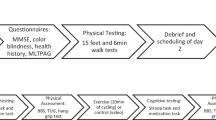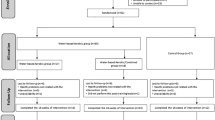Abstract
Background
Physical exercise has been reported to be the most effective method to improve cognitive function and brain health, but there is as yet no research on the effect of water-based exercise.
Aims
The aim of the present study was to compare the effects of water-based exercise with and without cognitive stimuli on cognitive and physical functions.
Methods
The design is a single-blind randomized controlled study. Twenty-one participants were randomly assigned to a normal water-based exercise (Nor-WE) group or a cognitive water-based exercise (Cog-WE) group. The exercise sessions were divided into two exercise series: a 10-min series of land-based warm-up, consisting of flexibility exercises, and a 50-min series of exercises in water. The Nor-WE consisted of 10 min of walking, 30 min of strength and stepping exercise, including stride over, and 10 min of stretching and relaxation in water. The Cog-WE consisted of 10 min of walking, 30 min of water-cognitive exercises, and 10 min of stretching and relaxation in water. Cognitive function, physical function, and ADL were measured before the exercise intervention (pre-intervention) and 10 weeks after the intervention (post-intervention).
Results
Participation in the Cog-WE performed significantly better on the pegboard test and the choice stepping reaction test and showed a significantly improved attention, memory, and learning, and in the general cognitive function (measured as the total score in the 5-Cog test). Participation in the Nor-WE dramatically improved walking ability and lower limb muscle strength.
Conclusion
Our results reveal that the benefits elderly adults may obtain from water-based exercise depend on the characteristics of each specific exercise program. These findings highlight the importance of prescription for personalized water-based exercises to elderly adults to improve cognitive function.

Similar content being viewed by others
References
Hillman CH, Belopolsky AV, Snook EM, Kramer AF, McAuley E (2004) Physical activity and executive control: implications for increased cognitive health during older adulthood. Res Q Exerc Sport 75:176–185
Carek PJ, Laibstain SE, Carek SM (2011) Exercise for the treatment of depression and anxiety. Int J Psychiatry Med 41:15–28
Abbott RD, White LR, Ross GW, Masaki KH, Curb JD et al (2004) Walking and dementia in physically capable elderly men. JAMA 292:1447–1453
Dik M, Deeg DJ, Visser M, Jonker C (2003) Early life physical activity and cognition at old age. J Clin Exp Neuropsychol 25:643–653
Kramer AF, Hahn S, Cohen NJ, Banich MT, McAuley E et al (1999) Ageing, fitness and neurocognitive function. Nature 400:418–419
Vaynman S, Ying Z, Gomez-Pinilla F (2004) Hippocampal BDNF mediates the efficacy of exercise on synaptic plasticity and cognition. Eur J Neurosci 20:2580–2590
Colcombe SJ, Erickson KI, Raz N, Webb AG, Cohen NJ et al (2003) Aerobic fitness reduces brain tissue loss in aging humans. J Gerontol A Biol Sci Med Sci 58:176–180
Endres M, Gertz K, Lindauer U, Katchanov J, Schultze J et al (2003) Mechanisms of stroke protection by physical activity. Ann Neurol 54:582–590
Vaynman S, Gomez-Pinilla F (2005) License to run: exercise impacts functional plasticity in the intact and injured central nervous system by using neurotrophins. Neurorehabil Neural Repair 19:283–295
Nagamatsu LS, Chan A, Davis JC, Beattie BL, Graf P et al (2013) Physical activity improves verbal and spatial memory in older adults with probable mild cognitive impairment: a 6-month randomized controlled trial. J Aging Res 2013:861893
Predovan D, Fraser SA, Renaud M, Bherer L (2012) The effect of three months of aerobic training on stroop performance in older adults. J Aging Res 2012:269815
Smith PJ, Blumenthal JA, Hoffman BM, Cooper H, Strauman TA et al (2010) Aerobic exercise and neurocognitive performance: a meta-analytic review of randomized controlled trials. Psychosom Med 72:239–252
Gregg EW, Pereira MA, Caspersen CJ (2000) Physical activity, falls, and fractures among older adults: a review of the epidemiologic evidence. J Am Geriatr Soc 48:883–893
Hauer K, Specht N, Schuler M, Bartsch P, Oster P (2002) Intensive physical training in geriatric patients after severe falls and hip surgery. Age Ageing 31:49–57
Skelton D, Dinan S, Campbell M, Rutherford O (2005) Tailored group exercise (Falls Management Exercise – FaME) reduces falls in community-dwelling older frequent fallers (an RCT). Age Ageing 34:636–639
Forwood MR, Larsen JA (2000) Exercise recommendations for osteoporosis. A position statement of the Australian and New Zealand Bone and Mineral Society. Aust Fam Physician 29:761–764
Jigami H, Sato D, Tsubaki A, Tokunaga Y, Ishikawa T et al (2012) Effects of weekly and fortnightly therapeutic exercise on physical function and health-related quality of life in individuals with hip osteoarthritis. J Orthop Sci 17:737–744
Sato D, Kaneda K, Wakabayashi H, Nomura T (2007) The water exercise improves health-related quality of life of frail elderly people at day service facility. Qual Life Res 16:1577–1585
Sato D, Kaneda K, Wakabayashi H, Nomura T (2009) Comparison of 2-year effects of once and twice weekly water exercise on activities of daily living ability of community dwelling frail elderly. Arch Gerontol Geriatr 49:123–128
Sato D, Kaneda K, Wakabayashi H, Nomura T (2009) Comparison two-year effects of once-weekly and twice-weekly water exercise on health-related quality of life of community-dwelling frail elderly people at a day-service facility. Disabil Rehabil 31:84–93
Sato D, Kaneda K, Wakabayashi H, Shimoyama Y, Baba Y et al (2011) Comparison of once and twice weekly water exercise on various bodily functions in community-dwelling frail elderly requiring nursing care. Arch Gerontol Geriatr 52:331–335
Netz Y, Dwolatzky T, Zinker Y, Argov E, Agmon R (2011) Aerobic fitness and multidomain cognitive function in advanced age. Int Psychogeriatr 23:114–124
Christensen J, Miftakhov R (2000) Hiatus hernia: a review of evidence for its origin in esophageal longitudinal muscle dysfunction. Am J Med 108(Suppl 4a):3S–7S
Lamoth CJ, van Deudekom FJ, van Campen JP, Appels BA, de Vries OJ et al (2011) Gait stability and variability measures show effects of impaired cognition and dual tasking in frail people. J Neuroeng Rehabil 8:2
Fauth EB, Schwartz S, Tschanz JT, Ostbye T, Corcoran C et al (2013) Baseline disability in activities of daily living predicts dementia risk even after controlling for baseline global cognitive ability and depressive symptoms. Int J Geriatr Psychiatry 28:597–606
Suzuki T, Shimada H, Makizako H, Doi T, Yoshida D et al (2013) A randomized controlled trial of multicomponent exercise in older adults with mild cognitive impairment. PLoS ONE 8:e61483
Levy R (1994) Aging-associated cognitive decline. working party of the international psychogeriatric association in collaboration with the world health organization. Int Psychogeriatr 6:63–68
Yatomi N (2010) Shuudan ninchi kensa Five cognitive functions test (in Japanese). Japan j geriatr psychiatry 21:215–220
Hasegawa K (1990) The clinical issues of age-related dementia. Tohoku J Exp Med 161(Suppl):29–38
Millor N, Lecumberri P, Gomez M, Martinez-Ramirez A, Izquierdo M (2013) An evaluation of the 30-s chair stand test in older adults: frailty detection based on kinematic parameters from a single inertial unit. J Neuroeng Rehabil 10:86
Duncan PW, Weiner DK, Chandler J, Studenski S (1990) Functional reach: a new clinical measure of balance. J Gerontol 45:M192–M197
Atwater SW, Crowe TK, Deitz JC, Richardson PK (1990) Interrater and test-retest reliability of two pediatric balance tests. Phys Ther 70:79–87
Schoppen T, Boonstra A, Groothoff JW, de Vries J, Goeken LN et al (1999) The Timed “up and go” test: reliability and validity in persons with unilateral lower limb amputation. Arch Phys Med Rehabil 80:825–828
Borg G, Linderholm H (1970) Exercise performance and perceived exertion in patients with coronary insufficiency, arterial hypertension and vasoregulatory asthenia. Acta Med Scand 187:17–26
Mihevic PM (1981) Sensory cues for perceived exertion: a review. Med Sci Sports Exerc 13:150–163
Larson EB, Wang L, Bowen JD, McCormick WC, Teri L et al (2006) Exercise is associated with reduced risk for incident dementia among persons 65 years of age and older. Ann Intern Med 144:73–81
Yaffe K, Barnes D, Nevitt M, Lui LY, Covinsky K (2001) A prospective study of physical activity and cognitive decline in elderly women: women who walk. Arch Intern Med 161:1703–1708
Colcombe S, Kramer AF (2003) Fitness effects on the cognitive function of older adults: a meta-analytic study. Psychol Sci 14:125–130
Colcombe SJ, Kramer AF, Erickson KI, Scalf P, McAuley E et al (2004) Cardiovascular fitness, cortical plasticity, and aging. Proc Natl Acad Sci U S A 101:3316–3321
Colcombe SJ, Erickson KI, Scalf PE, Kim JS, Prakash R et al (2006) Aerobic exercise training increases brain volume in aging humans. J Gerontol A Biol Sci Med Sci 61:1166–1170
Erickson KI, Prakash RS, Voss MW, Chaddock L, Heo S et al (2010) Brain-derived neurotrophic factor is associated with age-related decline in hippocampal volume. J Neurosci 30:5368–5375
Doi T, Makizako H, Shimada H, Park H, Tsutsumimoto K et al (2013) Brain activation during dual-task walking and executive function among older adults with mild cognitive impairment: a fNIRS study. Aging Clin Exp Res 25:539–544
Yoon JY, Okura T, Tsunoda K, Tsuji T, Kohda Y, Mitsuishi Y, Hasegawa C, Kin H (2014) Relationship between cognitive function and physical performance in older adults (in Japanese). The Jpn J Phys Fitness Sports Med 59(3):313–322
Sudo A, Tsunoda N, Ijiri K (2002) Effect of the underwater exercise on elderly persons with low muscle strength. (in Japanese). Ann Rep. Health Phys. Education Sport Science. 21:65–73
Bravo G, Gauthier P, Roy PM, Payette H, Gaulin P (1997) A weight-bearing, water-based exercise program for osteopenic women: its impact on bone, functional fitness, and well-being. Arch Phys Med Rehabil 78:1375–1380
Takeshima N, Rogers ME, Watanabe E, Brechue WF, Okada A et al (2002) Water-based exercise improves health-related aspects of fitness in older women. Med Sci Sports Exerc 34:544–551
Taaffe DR, Duret C, Wheeler S, Marcus R (1999) Once-weekly resistance exercise improves muscle strength and neuromuscular performance in older adults. J Am Geriatr Soc 47:1208–1214
Wajima H, Inoue S, Kikuchihara H, Ishikawa T, Sawada Y, Ikeda Y, Honma K, Mehata I (2003) Effect of fall prevention exercise in community dwelling frail elderly. Chiiki Hoken (in Japanese). 34(9):60–67
Acknowledgments
This study was supported by a Grant-in-Aid for Young Scientists (B) from the Ministry of Education, Culture, Sports, Science and Technology (MEXT) of Japan. It was also supported by a Grant-in-Aid for Advanced Research from the Niigata University of Health and Welfare. The authors would like to thank Enago (www.enago.jp) for the English language review.
Conflict of interest
None.
Author information
Authors and Affiliations
Corresponding author
Rights and permissions
About this article
Cite this article
Sato, D., Seko, C., Hashitomi, T. et al. Differential effects of water-based exercise on the cognitive function in independent elderly adults. Aging Clin Exp Res 27, 149–159 (2015). https://doi.org/10.1007/s40520-014-0252-9
Received:
Accepted:
Published:
Issue Date:
DOI: https://doi.org/10.1007/s40520-014-0252-9




